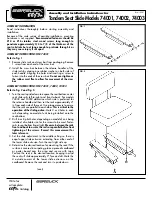
4
UR21S-MOI-IT-W-ML-10-22-Rev0
Watts Water Technologies, Inc.
EN
the Sensor from coming into contact with Silicone Vapours
(present in Paints and Sealants), Lead Tetraethyl or Esters
Phosphates. Other substances cause a temporary loss of
Sensitivity, these “Inhibitors” are Halogens, Hydrogen Sulfate,
Chlorine, Chlorinated Hydrocarbons. In the latter case, after
a short time in Clean Air, the Sensor resumes its normal
operation. Once the detection system starts up, it has to
be supplied with energy during all the lifetime of its sensors.
Seasonal use is not recommended
Mechanical Installation
For Sensors installation, follow the rules as in the diagram:
The positioning of the sensors must take into account not
only the aforementioned general rules, but also the following
installation rules; in particular the sensors must be installed:
•
Near possible gas leak points;
•
At least 1.5m from heat sources and ventilation open-
ings;
•
Never in poorly ventilated areas where gas pockets may
occur and, more generally, away from obstacles to the
natural movement of the gas;
•
Far from appliances that throughout their normal working
can have functional gas leakage (unless this is the pur-
pose of the detection);
•
In environments where atmospheric conditions are not
included in the technical characteristics.
•
The assembly and disassembly of the sensors must be
carried out when the appliance is not live.
The number of sensors to be installed in an environment is
proportional to its surface, its height and conformation, as
well as the relative density of the gas.
The installation must also take into account:
•
The geometry of the structures (beams, false ceilings,
wells, etc.
•
Mechanical and liquid protection
•
Poisoning protection
•
Accessibility for appliance maintenance.
The installation of the detectors must take place as late as
possible to avoid damage, but in time to adequately protect
the environment for which they are intended.
Environmetal compatibility and
disposal
This product has been designed and constructed using
materials and processes that take into account the environ-
mental issue. Refer to the following notes for disposal of the
product at the end of its working life, or when it is replaced:
•
for disposal purposes, this product is classified as an
electric and electronic device: do not dispose of it with
normal household waste, in particular as regards the
printed circuit
•
comply with all local laws in force
•
as far as possible reuse basic materials to keep environ-
mental impact to a minimum
•
use local depots and waste recycling companies, or
contact the supplier or manufacturer to return used
products or to ask for information on environmental
compatibility and waste disposal
•
the product packaging can be reused. Keep it for future
use or to return the product to the supplier.
Electrical Installation
CAUTION: Make sure that the area is safe and that the
device has been disconnected from the power supply
before starting any wiring and configuration operation.
Sensor installation must be carried out in accordance with
EN60079-14.
To enter cables, uses the cable gland provided on the housing.
The cable sheath cannot be larger than 8mm.
The sensor must be earthed using the appropriate system pro-
vided.
Terminal Block and electric
Connections
Shield
S
12 / 24Vdc
+
-
4 ÷ 20mA
-
+
Cabling
Depending on the connection distance, use a cable with at least
3 conductors with a minimum section of 0.75mm2 up to 100m,
1mm2 up to 200m, 1.5mm2 up to 500m.
In the presence of electromagnetic disturbances use shielded
cable.
If the relay board is present, use a multipolar cable suitable for
the number of connections.
The cable sheath must not exceed the diameter required by the
cable gland.
Card Guide for: Relay
or PhotoMOS Cards
Triple Jumpers J4
Dip Switch
SW1
Terminal Block TB
CN4
Connector for
Sensor Card
Sensor Card
Relay or PM Card
(on C1 connector)
CN3 connector for:
TUS40.. o Display Board
20-40 cm from the celling
Light Gas (e.g. Methane)
1,5-2 m from the floor
Gas with Density similar to Air
(e.g. Carbon Monoxide CO)
20-40 cm from
the floor
Heavy Gas (e.g.
Gasoline Vapours)
OK





































